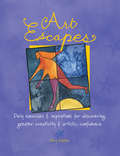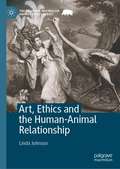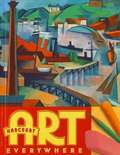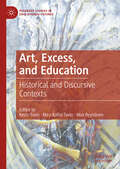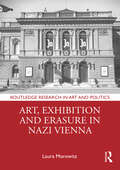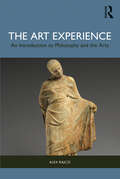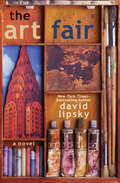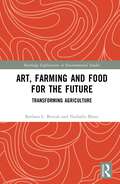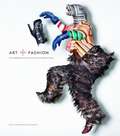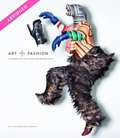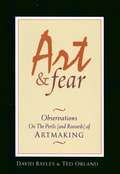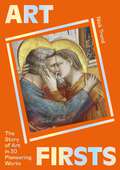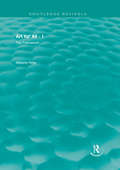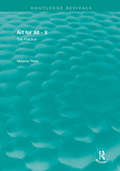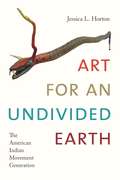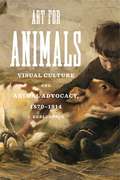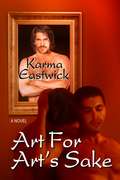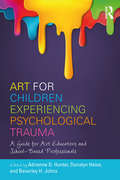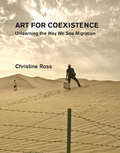- Table View
- List View
Art Escapes: Daily Exercises And Inspirations For Discovering Greater Creativity And Artistic Confidence
by Dory KanterInspire your creative spirit - everyday! Whether you're a beginner or an experienced artist, Art Escapes provides the ideas and encouragement you need to discover greater creativity and artistic confidence, even when you're short on time. Professional artist and instructor Dory Kanter shows you how to: Experience more fun and greater confidence drawing and painting * Express yourself and experiment everyday with an art journal * Reinterpret daily life with simple, beautiful sketches * Find painting inspiration in unexpected places * Paint freely, intuitively and passionately with a simple four-step approach * Create new forms of art, including watercolor mosaics, paper weavings and found object collages. You'll also find 13 drawing, watercolor, mixed media, and assemblage projects, plus several "page-a-day" ideas.With Art Escapes, you'll learn how to build an art "habit," one that brings joy with every stroke of your brush.
Art, Ethics and the Human-Animal Relationship (The Palgrave Macmillan Animal Ethics Series)
by Linda JohnsonThis book examines the works of major artists between the seventeenth and nineteenth centuries, as important barometers of individual and collective values toward non-human life. Once viewed as merely representational, these works can also be read as tangential or morally instrumental by way of formal analysis and critical theories. Chapter Two demonstrates the discrimination toward large and small felines in Genesis and The Book of Revelation. Chapter Three explores the cruel capture of free roaming animals and how artists depicted their furs, feathers and shells in costume as symbols of virtue and vice. Chapter Four identifies speciest beliefs between donkeys and horses. Chapter Five explores the altered Dutch kitchen spaces and disguised food animals in various culinary constructs in still life painting. Chapter Six explores the animal substances embedded in pigments. Chapter Seven examines animals in absentia-in the crafting of brushes. The book concludes with the fish paintings of William Merritt Chase whose glazing techniques demonstrate an artistic approach that honors fishes as sentient beings.
Art Everywhere
by Jacqueline Chanda Kristen Pederson MarstallerThe book is all about art production and its elements and principles.
Art Everywhere (Level #3)
by Jacqueline Chanda Kristen Pederson MarstallerIn this book, authors describe artworks made from paints, clay, yarn--even old baseballs.
Art Everywhere (Level #2)
by Jacqueline Chanda Kristen Pederson MarstallerIn this book, authors describe art made by all kinds of artists--grown-ups and children.
Art Everywhere
by Jacqueline Chanda Kristen Pederson MarstallerIn this book, you will see art from all over the world and from many different time periods. As you learn about these artworks and the artists who created them, you will design and create your own artworks.
Art Everywhere
by Jacqueline Chanda Kristen Pederson MarstallerIn this book, you will be introduced to artists and artworks from around the world and across the centuries. You will learn what the smallest sketch and the largest sculpture have in common--the elements of art and the principles of design that can be found in all artworks.
Art, Excess, and Education: Historical and Discursive Contexts (Palgrave Studies in Educational Futures)
by Kevin Tavin Mira Kallio-Tavin Max RyynänenThis book concentrates on the deep historical, political, and institutional relationships between art, education, and excess. Going beyond field specific discourses of art history, art criticism, philosophy, and aesthetics, it explores how the concept of excess has been important and enduring from antiquity through contemporary art, and from early film through the newer interactive media. Examples considered throughout the book focus on disgust, grandiosity, sex, violence, horror, disfigurement, endurance, shock, abundance, and emptiness, and frames them all within an educational context. Together they provide theories and classificatory systems, historical and political interpretations of art and excess, examples of popular culture, and suggestions for the future of educational practice.
Art, Exhibition and Erasure in Nazi Vienna (Routledge Research in Art and Politics)
by Laura MorowitzThis book examines three exhibitions of contemporary art held at the Vienna Künstlerhaus during the period of National Socialist rule and shows how each attempted to culturally erase elements anathema to Nazi ideology: the City, the Jewess and fin-de-siècle Vienna. Each of the exhibits was large scale and ambitious, part of a broader attempt to situate Vienna as the cultural capital of the Reich, and each aimed to reshape cultural memory and rewrite history. Applying illuminating theories on memory studies, collective and public memory, and notions of "memoricide," this is the first book in English to focus on visual culture in the period when Austria was erased as a nation and incorporated into the Third Reich as "Ostmark." The organization, content and publications surrounding these three exhibits are explored in depth and set against the larger political changes and dangerous ideologies they reflect. The book will be of interest to scholars working in art history, museum studies, cultural history, memory studies, art and politics and Holocaust studies.
The Art Experience: An Introduction to Philosophy and the Arts
by Alex RajcziThe Art Experience: An Introduction to Philosophy and the Arts takes readers on an engaging and accessible journey that explores a series of fundamental questions about the nature of art and aesthetic value. The book’s 12 chapters explore three questions: What makes something a work of art? How should we experience art to get the most out of it? Once we understand art, how should we evaluate whether it is good or bad? Philosophical theory is illustrated with concrete examples: the paintings of Frida Kahlo, the music of Johann Sebastian Bach, the masks of the Nso people, and many others. Classic questions are balanced with cutting-edge challenges, such as Linda Nochlin’s work on the exclusion of women from the artistic canon.The Art Experience presupposes no prior knowledge of philosophy or art, and it will be of interest to any reader seeking an accessible and engaging introduction to this field. Along the way, readers learn how philosophical theories can affect our real-world experiences with painting, music, theater, and many other art forms.Key Features Accessible for any college student: assumes no knowledge of philosophy, art theory, or any artistic medium Organizes topics conceptually, rather than historically, allowing students to more easily grasp the core issues themselves rather than tracing their historical evolution Offers readers a large number of contemporary examples and a consistent focus on the way theory can affect people’s real-world experiences with art Explores questions about bias – for example, whether the artistic canon has excluded some groups unfairly and whether definitions of art are Western-biased
The Art Fair: A Novel
by David LipskyA poignant and painfully funny novel about the New York art world by the acclaimed author of Although of Course You End Up Becoming YourselfFor two first-class years, Joan Freeley had it all: the perfect family, the best art dealer in Manhattan, and the admiration of famous friends. Her adoring husband and two handsome sons attended her first gallery show in matching khakis and blue blazers. &“An Interesting Talent Makes Its Debut,&” declared the New York Times. Then, as if her success were nothing more than a booking error, Joan&’s life got downgraded. A brutal divorce led to paintings too bitter to sell and a career stuck firmly in coach. Unable to see her suffer alone any longer, Joan&’s teenage son Richard leaves his father and older brother in Los Angeles and moves in to her one-bedroom apartment in SoHo. At the gallery openings where she used to be a star, Richard discovers just how much his mother&’s light has dimmed. She is an artist who is not showing—she might as well be invisible. To acknowledge her is to acknowledge the thin line between success and failure in a world as superficial as it is intoxicating. Richard immediately devotes himself to returning his mother to her former glory. Everything about him—the clothes he wears, the jokes he makes, the college he attends—is calculated to boost Joan&’s reputation. But as the years go by and the galleries keep sending back her slides, Richard has to ask: Who wants Joan Freeley&’s resurrection more—him or her? And when will his own life start?
Art, Farming and Food for the Future: Transforming Agriculture (Routledge Explorations in Environmental Studies)
by Barbara L. Benish Nathalie BlancThis book explores the impact of artistic experiments in inspiring people to turn away from current food consumerism and take an active role in preserving, sustaining, and protecting the environment. As artists are expanding their practice into social justice and community concerns, erasing traditional forms of expression and integrating others, the culture around food and its production has been added to a new vocabulary of experiential art. The authors measure the impact of such experiments on local food consumption and production, focusing on education and youth, both in the surrounding community and culture at large. They suggest how these projects can be up-scaled to further encourage sustainable solutions for our environment and communities. The book explores the reflections and motivations of case study practitioners in urban and rural areas and, through interviews, engages with artists who are pioneering a new trend to create hubs of activity away from traditional art spaces in cities to follow a non-hierarchal practice that is de-centralized and communally based. This book will be of great interest to academic readers concerned with issues related to environmental aesthetics, eco-design, eco-criticism, culture, heritage, memory, and identity, and those interested in the current debates on the place of aesthetics and culture in sustainability.
Art + Fashion
by E. P. Cutler Julien TomaselloA volume of magnificent proportions, Art + Fashion is as exciting and elegant as the creative partnerships it celebrates. Spanning numerous eras, men and women's fashion, and a wide range of art mediums, these 25 collaborative projects reveal the astonishing work that results when luminaries from the art world (such as Pollock, Haring, and Hirst) come together with icons of the fashion world (including Saint Laurent, Westwood, McQueen). From 20th-century legends such as Elsa Schiaparelli and her famous lobster dress painted by Salvador Dalí to 21st-century trailblazers such as Cindy Sherman and her self-portraits in vintage Chanel, these electric and provocative pairings--represented in lavish visuals and thoughtful essays reflecting on the history of each project--brim with the energy and possibility of powerful forces uniting.
Art + Fashion, Abridged Reading Edition
by E. P. Cutler Julien TomaselloArt + Fashion is as exciting and elegant as the creative partnerships it celebrates. In this abridged reading edition, readers will enjoy the book's sparkling and informative text in its entirety, plus a single stunning representative photo of each of the 25 collaborative projects profiled. Spanning numerous eras, men and women's fashion, and a wide range of art mediums, these collaborations reveal the astonishing work that results when luminaries from the art world (such as Pollock, Haring, and Hirst) come together with icons of the fashion world (including Saint Laurent, Westwood, McQueen). From 20th-century legends such as Elsa Schiaperelli and her famous lobster dress painted by Salvador Dalí to 21st-century trailblazers such as Cindy Sherman and her self-portraits in vintage Chanel, these electric and provocative pairings brim with the energy and possibility of powerful forces uniting.
Art & Fear
by David Bayles Ted Orland"This is a book about making art. Ordinary art. Ordinary art means something like: all art not made by Mozart. After all, art is rarely made by Mozart-like people; essentially--statistically speaking--there aren't any people like that. Geniuses get made once-a-century or so, yet good art gets made all the time, so to equate the making of art with the workings of genius removes this intimately human activity to a strangely unreachable and unknowable place. For all practical purposes making art can be examined in great detail without ever getting entangled in the very remote problems of genius."---from the IntroductionArt & Fear explores the way art gets made, the reasons it often doesn't get made, and the nature of the difficulties that cause so many artists to give up along the way. The book's co-authors, David Bayles and Ted Orland, are themselves both working artists, grappling daily with the problems of making art in the real world. Their insights and observations, drawn from personal experience, provide an incisive view into the world of art as it is expeienced by artmakers themselves.This is not your typical self-help book. This is a book written by artists, for artists --- it's about what it feels like when artists sit down at their easel or keyboard, in their studio or performance space, trying to do the work they need to do. First published in 1994, Art & Fear quickly became an underground classic. Word-of-mouth response alone--now enhanced by internet posting--has placed it among the best-selling books on artmaking and creativity nationally.Art & Fear has attracted a remarkably diverse audience, ranging from beginning to accomplished artists in every medium, and including an exceptional concentration among students and teachers. The original Capra Press edition of Art & Fear sold 80,000 copies.An excerpt:Today, more than it was however many years ago, art is hard because you have to keep after it so consistently. On so many different fronts. For so little external reward. Artists become veteran artists only by making peace not just with themselves, but with a huge range of issues. You have to find your work...
Art Firsts: The Story of Art in 30 Pioneering Works
by Nick TrendThe story of art is not always the story of art-historical 'isms' and complex academic debate. The real history is often the story of some very simple firsts - the first time an artist painted themselves, the first time someone painted a smile, the first actual place to be depicted, the first feminist artwork, the first anti-war work.Art evolves and revolutionises itself through these simple - but ground-breaking - creative leaps. Art Firsts brings together 30 of these pioneering firsts to piece together an original approach to looking at and appreciating art, as well as understanding where it has come from and how it relates to you. Each first is approachable and engaging, while each work is simply and satisfyingly explained. Every work is also fully illustrated, and its significance is shown through images of the subsequent artists directly inspired by them. Art Firsts offers a refreshing and fascinating narrative for those curious about why so-called 'masterpieces' are so important and how the story of art can be boiled down to flashes of fascinating brilliance.
Art Firsts: The Story of Art in 30 Pioneering Works
by Nick TrendThe story of art is not always the story of art-historical 'isms' and complex academic debate. The real history is often the story of some very simple firsts - the first time an artist painted themselves, the first time someone painted a smile, the first actual place to be depicted, the first feminist artwork, the first anti-war work.Art evolves and revolutionises itself through these simple - but ground-breaking - creative leaps. Art Firsts brings together 30 of these pioneering firsts to piece together an original approach to looking at and appreciating art, as well as understanding where it has come from and how it relates to you. Each first is approachable and engaging, while each work is simply and satisfyingly explained. Every work is also fully illustrated, and its significance is shown through images of the subsequent artists directly inspired by them. Art Firsts offers a refreshing and fascinating narrative for those curious about why so-called 'masterpieces' are so important and how the story of art can be boiled down to flashes of fascinating brilliance.
Art for All - I: The Framework (Routledge Revivals)
by Melanie PeterOriginally published in 1996, Art for All is aimed at the non-specialist teacher of art, and offers a practical approach for working with pupils with wide-ranging learning needs. It presents a developmental framework for art in the light of National Curriculum requirements, with strategies for structuring and supporting appropriate art activity. It is presented in two volumes with colour illustrations: The Framework, which describes the principles of art education in relation to pupils learning difficulties and The Practice, which deals with the specifics of delivering these principles in the classroom. Whilst they stand as independent texts, they are intended to be used together. Art for All will be of interest to all those working in this and related fields in mainstream as well as special education.
Art for All - II: The Practice (Routledge Revivals)
by Melanie PeterOriginally published in 1996, Art for All is aimed at the non-specialist teacher of art, and offers a practical approach for working with pupils with wide-ranging learning needs. It presents a developmental framework for art in the light of National Curriculum requirements, with strategies for structuring and supporting appropriate art activity. It is presented in two volumes with colour illustrations: The Framework, which describes the principles of art education in relation to pupils learning difficulties and The Practice, which deals with the specifics of delivering these principles in the classroom. Whilst they stand as independent texts, they are intended to be used together. Art for All will be of interest to all those working in this and related fields in mainstream as well as special education.
Art for an Undivided Earth: The American Indian Movement Generation
by Jessica L. HortonIn Art for an Undivided Earth Jessica L. Horton reveals how the spatial philosophies underlying the American Indian Movement (AIM) were refigured by a generation of artists searching for new places to stand. Upending the assumption that Jimmie Durham, James Luna, Kay WalkingStick, Robert Houle, and others were primarily concerned with identity politics, she joins them in remapping the coordinates of a widely shared yet deeply contested modernity that is defined in great part by the colonization of the Americas. She follows their installations, performances, and paintings across the ocean and back in time, as they retrace the paths of Native diplomats, scholars, performers, and objects in Europe after 1492. Along the way, Horton intervenes in a range of theories about global modernisms, Native American sovereignty, racial difference, archival logic, artistic itinerancy, and new materialisms. Writing in creative dialogue with contemporary artists, she builds a picture of a spatially, temporally, and materially interconnected world—an undivided earth.
Art for Animals: Visual Culture and Animal Advocacy, 1870–1914 (Animalibus: Of Animals and Cultures #12)
by J. Keri CroninAnimal rights activists today regularly use visual imagery in their efforts to shape the public’s understanding of what it means to be “kind,” “cruel,” and “inhumane” toward animals. Art for Animals explores the early history of this form of advocacy through the images and the people who harnessed their power.Following in the footsteps of earlier-formed organizations like the RSPCA and ASPCA, animal advocacy groups such as the Victoria Street Society for the Protection of Animals from Vivisection made significant use of visual art in literature and campaign materials. But, enabled by new and improved technologies and techniques, they took the imagery much further than their predecessors did, turning toward vivid, pointed, and at times graphic depictions of human-animal interactions. Keri Cronin explains why the activist community embraced this approach, details how the use of such tools played a critical role in educational and reform movements in the United States, Canada, and England, and traces their impact in public and private spaces. Far from being peripheral illustrations of points articulated in written texts or argued in impassioned speeches, these photographs, prints, paintings, exhibitions, “magic lantern” slides, and films were key components of animal advocacy at the time, both educating the general public and creating a sense of shared identity among the reformers.Uniquely focused on imagery from the early days of the animal rights movement and filled with striking visuals, Art for Animals sheds new light on the history and development of modern animal advocacy.
Art for Animals: Visual Culture and Animal Advocacy, 1870–1914 (Animalibus)
by J. Keri CroninAnimal rights activists today regularly use visual imagery in their efforts to shape the public’s understanding of what it means to be “kind,” “cruel,” and “inhumane” toward animals. Art for Animals explores the early history of this form of advocacy through the images and the people who harnessed their power.Following in the footsteps of earlier-formed organizations like the RSPCA and ASPCA, animal advocacy groups such as the Victoria Street Society for the Protection of Animals from Vivisection made significant use of visual art in literature and campaign materials. But, enabled by new and improved technologies and techniques, they took the imagery much further than their predecessors did, turning toward vivid, pointed, and at times graphic depictions of human-animal interactions. Keri Cronin explains why the activist community embraced this approach, details how the use of such tools played a critical role in educational and reform movements in the United States, Canada, and England, and traces their impact in public and private spaces. Far from being peripheral illustrations of points articulated in written texts or argued in impassioned speeches, these photographs, prints, paintings, exhibitions, “magic lantern” slides, and films were key components of animal advocacy at the time, both educating the general public and creating a sense of shared identity among the reformers.Uniquely focused on imagery from the early days of the animal rights movement and filled with striking visuals, Art for Animals sheds new light on the history and development of modern animal advocacy.
Art for Art's Sake
by Karma EastwickIn the quaint, sleepy college town of Huntsville, history has an eerie way of repeating itself generation after generation ...When in-the-closet college student Matthew Rhodes arrives at the old building in the town's historical district, little does he realize his life is about to take a sudden and dramatic turn. He is certainly prepared to earn extra income by posing nude for erotica artist Skylar Novak, and definitely anxious to discover if the sexy and reclusive man has an interest in him other than one of an artistic nature. But things get complicated when Matthew meets a handsome stranger lurking outside the artist's door. A stranger who has a sudden and compelling effect on him before disappearing in the blink of an eye.Matthew and Skylar quickly discover they share both an uncontrollable and supernatural bond with each other, leading to a red-hot and steamy affair, but they also realize they are mysteriously linked to the stranger. Is he even a man at all, or could he be an entity from another plane of existence with lecherous designs of his own? And could his connection to Matthew and Skylar have historical significance, involving an elaborate and desperate plan that has miserably failed every generation for centuries?Before the situation can drive him insane, Matthew is determined to open his mind to new possibilities and learn the whole truth. But in doing so, will his burgeoning love and unquenchable sexual appetite for Skylar, the man of his dreams, suffer in the process? Or will his actions secure their love for eternity?
Art for Children Experiencing Psychological Trauma: A Guide for Art Educators and School-Based Professionals
by Adrienne D. Hunter Donalyn Heise Beverley H. JohnsArt for Children Experiencing Psychological Trauma aims to increase understanding of art’s potential to enhance learning for children living in crisis. In this ground-breaking resource, the first of its kind to focus specifically on the connection between art education and psychological trauma in youth populations, readers can find resources and practical strategies for both teachers and other school-based professionals. Also included are successful models of art education for diverse populations, with specific attention to youth who face emotional, mental, behavioral, and physical challenges, as well a framework for meaningful visual arts education for at-risk/in-crisis populations.
Art for Coexistence: Unlearning the Way We See Migration
by Christine RossAn exploration of how contemporary art reframes and humanizes migration, calling for coexistence—the recognition of the interdependence of beings.In Art for Coexistence, art historian Christine Ross examines contemporary art&’s response to migration, showing that art invites us to abandon our preconceptions about the current &“crisis&”—to unlearn them—and to see migration more critically, more disobediently. We (viewers in Europe and North America) must come to see migration in terms of coexistence: the interdependence of beings. The artworks explored by Ross reveal, contest, rethink, delink, and relink more reciprocally the interdependencies shaping migration today—connecting citizens-on-the-move from some of the poorest countries and acknowledged citizens of some of the wealthiest countries and democracies worldwide. These installations, videos, virtual reality works, webcasts, sculptures, graffiti, paintings, photographs, and a rescue boat, by artists including Banksy, Ai Weiwei, Alejandro González Iñárritu, Laura Waddington, Tania Bruguera, and others, demonstrate art&’s power to mediate experiences of migration. Ross argues that art invents a set of interconnected calls for more mutual forms of coexistence: to historicize, to become responsible, to empathize, and to story-tell. Art history, Ross tells us, must discard the legacy of imperialist museology—which dissocializes, dehistoricizes, and depoliticizes art. It must reinvent itself, engaging with political philosophy, postcolonial, decolonial, Black, and Indigenous studies, and critical refugee and migrant studies.
